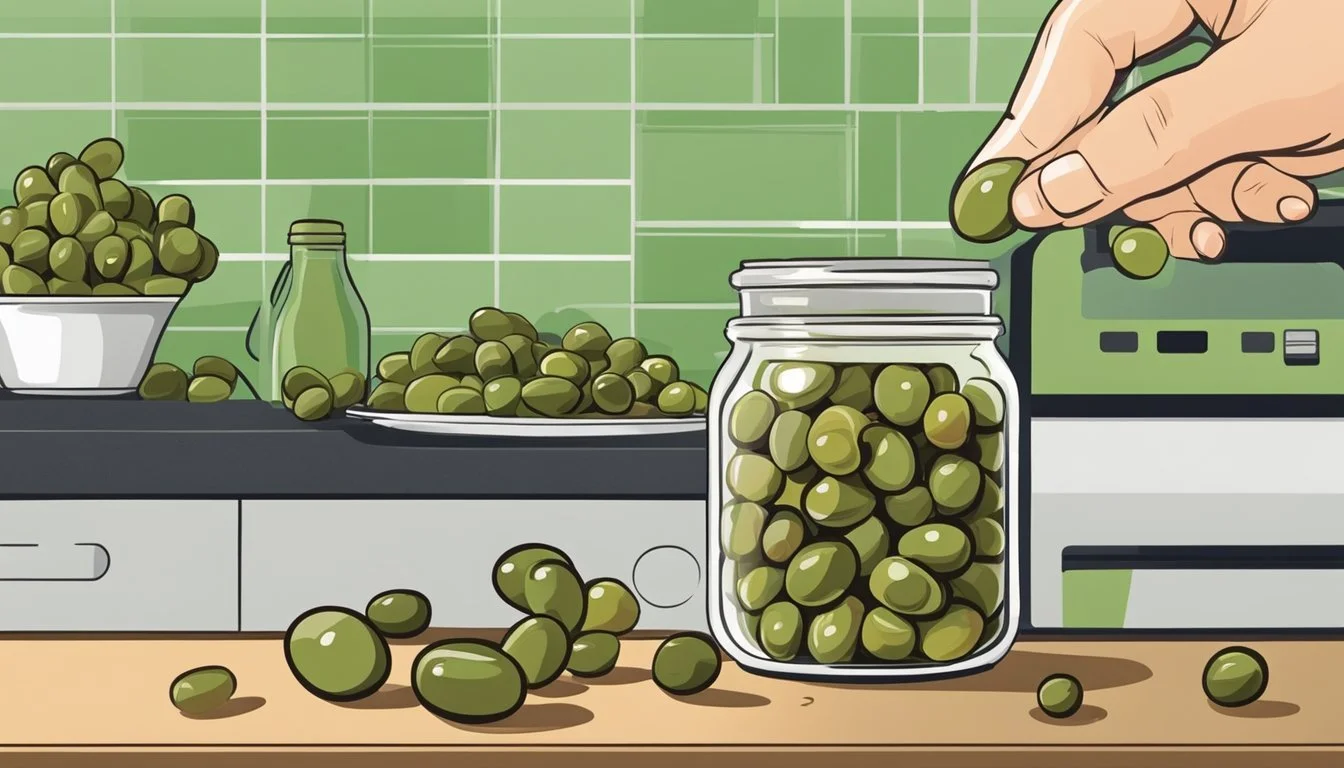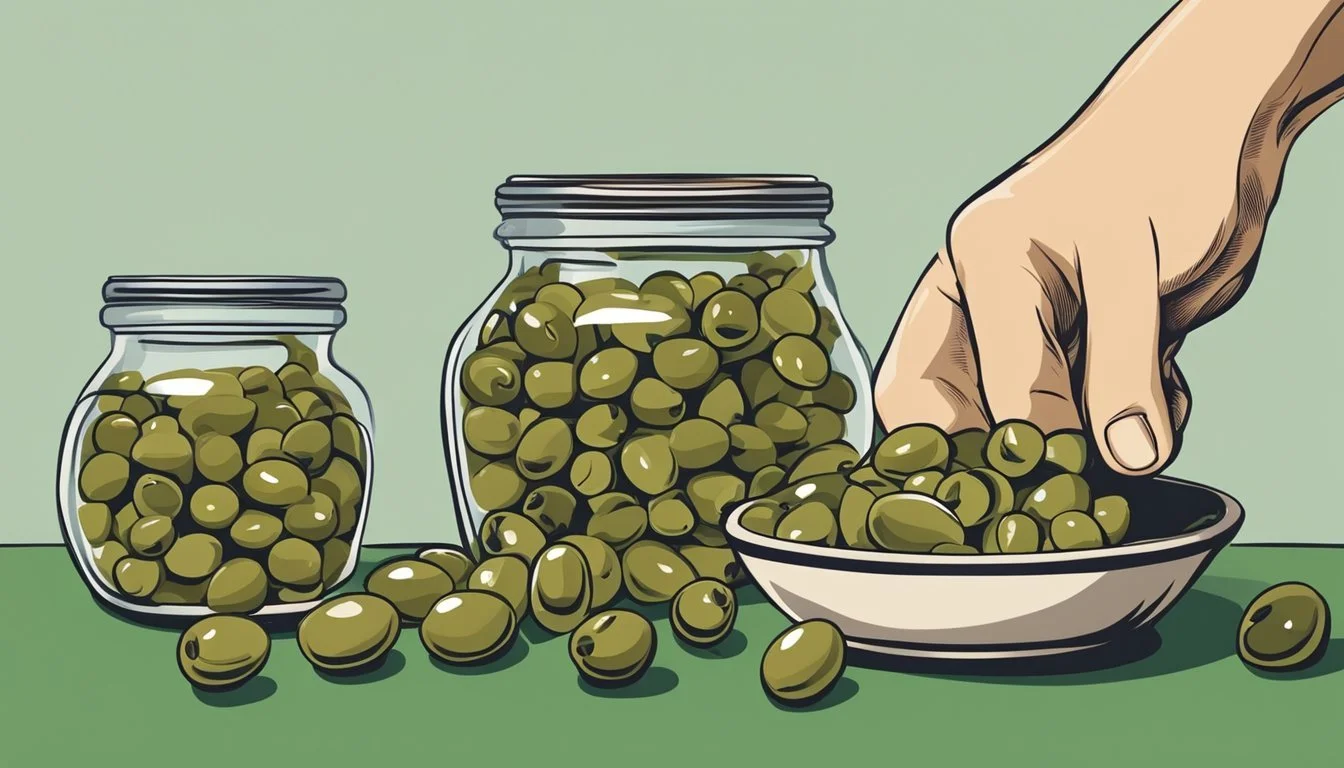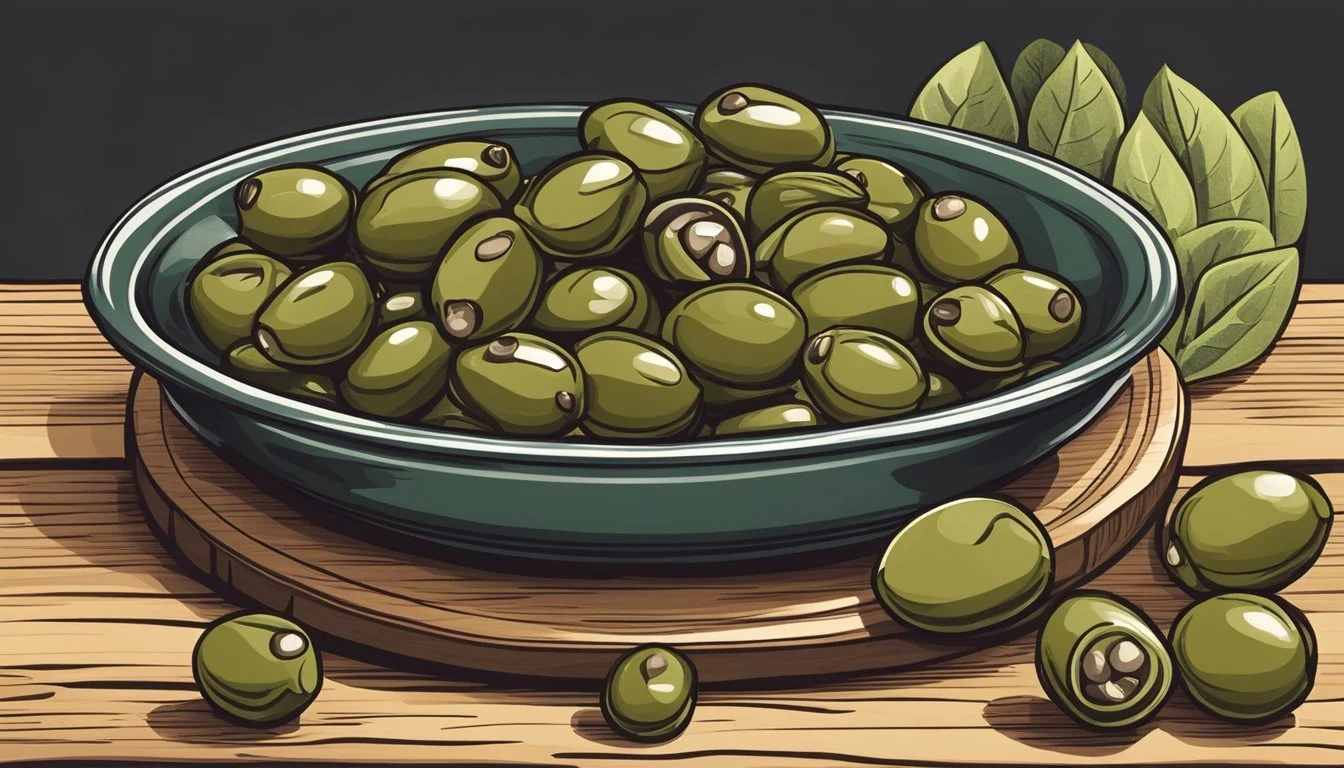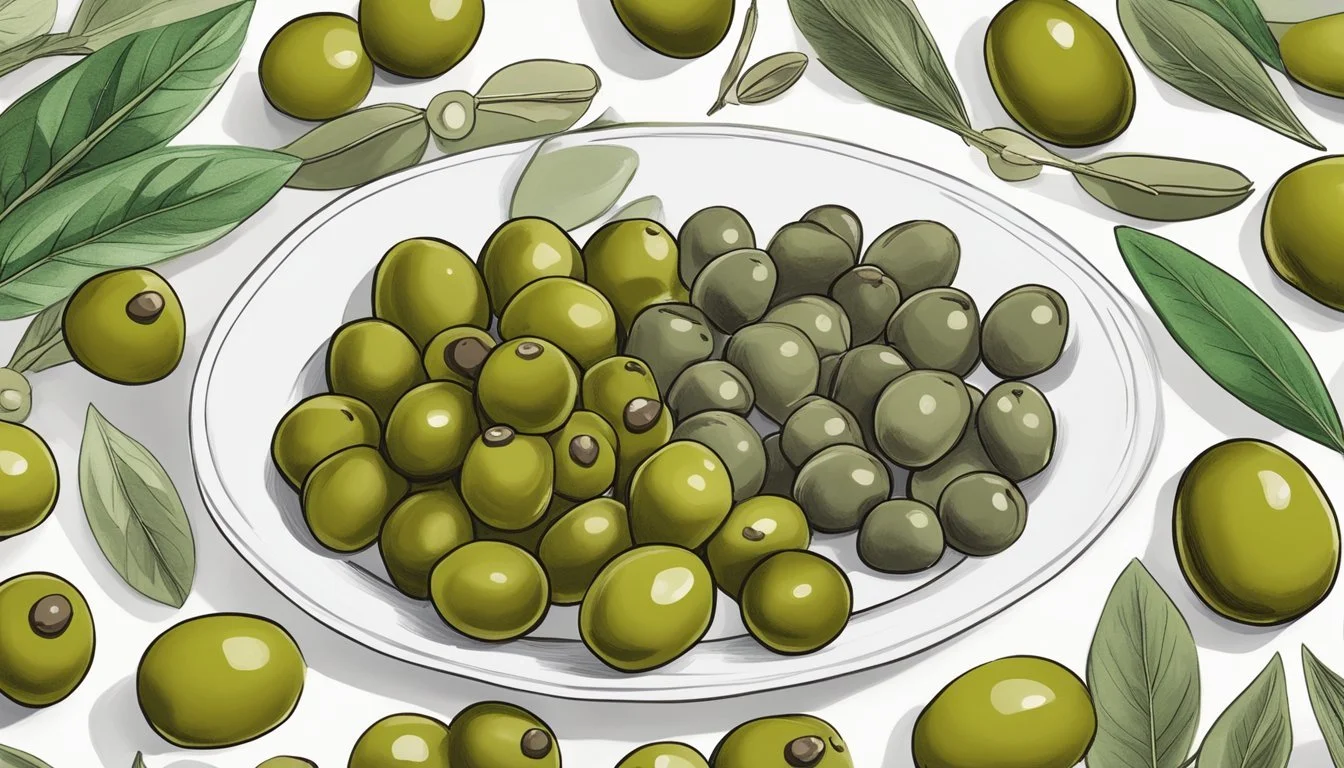How to Substitute Capers for Green Olives
A Simple Swap Guide
Substituting capers (What wine goes well with capers?) for green olives can be an excellent way to adapt a recipe to suit one's taste or to cater to availability. Both capers and green olives bring a distinct, piquant flavor to dishes; capers, with their small, round and bud-like shape, offer a sharp, tangy punch, while green olives, larger and more substantial, bring a salty and slightly bitter taste. For individuals looking to capture the essence of green olives without their unique texture or for those simply out of green olives, capers provide a comparable briny flavor profile.
When looking to make the switch from green olives to capers, they should consider size, texture, and the intensity of flavor. Because capers are considerably smaller than green olives, one can chop them up as needed or use them whole, depending on the dish. The substitution not only adds the necessary salty and acidic notes but also maintains the characteristic green color that green olives would contribute to the recipe.
It is important to adjust quantities appropriately to avoid overpowering the dish with the capers' robust taste. A direct one-to-one substitution might not always be ideal; chefs may experiment with proportions, using less caper brine or fewer capers to achieve a balanced flavor. Through careful consideration of these factors, capers can effectively replace green olives in a variety of recipes, ranging from salads and sauces to main dishes like chicken piccata (What wine goes well with chicken piccata?) or beef tartare (What wine goes well with beef tartare?).
Understanding Capers and Green Olives
Capers are the unripened flower buds of the Capparis spinosa plant, known for their distinctive tangy lemon-like flavor. They are most commonly pickled in brine or packed in salt, which enhances their unique taste profile. Due to their intense flavor, capers are typically used sparingly in Mediterranean cuisine.
Green olives, on the other hand, are the unripe fruit of the olive tree. They share a salty, slightly bitter taste with capers but have a firmer texture. Green olives are often cured in brine or packed in vinegar which contributes to their piquant flavor.
Comparison between Capers and Green Olives:
Aspect Capers Green Olives Part of Plant Flower buds Fruit Flavor Tangy, lemony, salty Salty, slightly bitter Texture Tender, juicy Firmer, meaty Usage In smaller quantities More versatile in quantity Curing In brine or salt In brine, salt, or vinegar
Both capers and green olives enhance dishes with a burst of salinity and acidity which makes them interchangeable in certain recipes. While capers are typically minced due to their smaller size, green olives can be chopped to approximate the capers' presence in a dish. They can be used in salads, pasta, sauces, and as garnishes. While substituting, attention should be given to the respective intensities of flavor they impart to a meal.
The Role of Capers and Green Olives in Cooking
Capers and green olives serve distinct purposes in culinary applications, with each bringing a unique blend of salty, briny flavors and vibrant textures to various dishes. They are versatile ingredients that can be incorporated into a range of recipes, from salads to pasta dishes (What wine goes well with pasta dishes?), and even in enhancing sauces and dressings.
Incorporating into Salads
Salads benefit from the incorporation of capers or chopped green olives, as they introduce a salty punch and an appealing texture contrast. In a pasta salad, for instance, capers can be sprinkled throughout for sharp, tangy bursts, while green olives, with their firmer bite, can be sliced to provide a more substantial presence. Their use in salads aligns with the trend for healthy food, with their ability to add depth without excessive calories.
Salad Ingredient: Textural Impact
Capers: Small bursts of tartness
Green Olives: Firm, substantial pieces
Enhancing Pasta Dishes
In pasta dishes, both ingredients excel at enriching and balancing flavors. Capers, when added to a pasta puttanesca, contribute pops of flavor that contrast with the richness of tomatoes and anchovies. (What wine goes well with anchovies?) Green olives, on the other hand, can be used to achieve a similar effect, providing saline notes that enhance dishes like a robust Kalamata olive tapenade spread over pasta.
Pasta Dish: Flavor Contribution
Capers: Tangy and briny highlights
Green Olives: Oily richness and saltiness
Elevating Sauces and Dressings
Capers are often spotlighted in sauces or dressings for their ability to add a briny kick without overpowering the dish—ideal for a delicate vinaigrette on a garden salad. Green olives might be minced and whisked into dressings, where they provide body and complexity to the flavor profile. In heavier sauces, their robust texture and taste can stand up to other intense ingredients, enhancing the overall dish's savoriness.
Sauces/Dressings: Role in Flavor and Consistency
Capers: Accentuates with a sharp, vinegary hit
Green Olives: Adds depth and richness to the body
Culinary Substitutes for Capers
When looking for a substitute for capers, one must consider the ingredient's briny, tangy flavor profile. The following substitutes offer complementary flavors and textures suitable for various dishes, enabling the preservation of the intended culinary experience.
Using Kalamata Olives as a Substitute
Kalamata olives, characterized by their deep purple color and smooth, meaty texture, serve as an excellent stand-in for capers. They impart a similar salty tang but have a more pronounced fruity flavor. When substituting, one can use kalamata olives in equal measure but should finely chop them to match the size of capers.
Alternative Flavor Enhancers
Beyond olives, several other ingredients can replicate the distinctive qualities of capers:
Green peppercorns: Provide a mildly sharp flavor with a hint of heat, great for giving dishes a comparable piquancy.
Thyme: Delivers a floral and earthy note that can create a similar depth of flavor in recipes calling for capers.
Ingredients should be chosen based on the desired flavor outcome and dish compatibility.
Common Replacement Ingredients
A variety of common kitchen staples can replace capers to achieve the desired culinary effect:
Black olives: Offer a milder flavor but retain the capers' saltiness; chop finely before using.
Artichoke hearts: Their subtle tanginess and soft texture make them a fitting alternative when chopped small.
Anchovies: While considerably different in taste, these can contribute a comparable umami and saltiness to the dish.
Nasturtium seeds: Less common, but their peppery taste can stand in for the caper's flavor in pickled form.
Choosing the appropriate substitute will largely depend on the specific recipe and flavor profile being targeted.
Substituting Capers for Green Olives
When replacing capers with green olives, it's important to balance the unique flavor and texture differences to achieve a result similar to the original recipe. This section will guide you through making these adjustments carefully and confidently.
Adjusting for Flavor Balance
Green olives provide a salty and slightly bitter taste that can mimic the sharpness of capers. However, they lack the capers' inherent tanginess, so adding a squeeze of lemon juice can help replicate the capers' acidity. To start, one can replace each tablespoon of capers with about one tablespoon of chopped green olives, adding lemon juice to taste.
Texture Considerations
The texture of green olives is more substantial and less delicate compared to capers. For recipes where texture plays a crucial role, finely chop the olives to better resemble the size and bite of capers. This helps in dishes where capers provide a subtle contrast rather than a dominant texture.
Proportion and Taste Testing
The key to successfully substituting capers with green olives lies in the proportion and continuous taste-testing during the cooking process. A general guideline is to use equal amounts of finely chopped green olives to replace capers, but the chef should adjust according to their taste preferences, considering the stronger flavor profile of olives.
Recommended proportions:
1 tablespoon capers = 1 tablespoon finely chopped green olives
Add lemon juice according to taste, starting with a few drops and adjusting as needed.
It's crucial to taste as you go, ensuring the salty, tangy balance is achieved without overpowering the dish. Remember, substitution is not just a matter of swapping but also of carefully adjusting to replicate the original dish's intended flavor and texture profile as closely as possible.
Practical Tips for Substitution
When substituting capers for green olives, it's important to ensure the replacement complements the dish's flavor profile and maintains the intended culinary balance.
Shopping for Substitutes
In the grocery store, one may find ideal replacements for capers in the condiments or international foods aisle. Chopped kalamata olives are one of the most suitable substitutes, as their salty and slight bitterness closely matches that of capers. Be sure to look for pitted varieties to save time and effort. Alternatively, one can opt for caperberries, which are larger but have a milder taste. Additionally, pickled red onions can introduce a similar zesty flavor to a dish.
Homemade Alternatives
For those who prefer a more hands-on approach, creating a homemade olive mix can be a suitable substitution for capers. Chopping green olives and infusing them with a bit of fresh thyme can add a unique twist, imbuing dishes with a similar Mediterranean flair. One may also prepare a brine to pickle onions or other vegetables at home for a personalized caper alternative.
Preservation and Storage
Both capers and their substitutes should be stored properly to preserve their taste and quality. For purchased items like chopped kalamata olives or caperberries, it's essential to keep them refrigerated in their brine once opened to prolong their shelf life. Homemade pickled substitutes should be kept in airtight containers, refrigerated, and ideally consumed within a month to ensure freshness.
Recipe Adaptations with Alternatives
In the quest for culinary diversity, green olives serve as an adept substitute for capers, offering a similar briny, tangy flavor profile to dishes. This section covers specific adaptations for various recipes when green olives replace capers.
Modification for Meat Dishes
For meat dishes such as chicken piccata, the substitution should be done with care. Green olives can be chopped finely to emulate the size of capers and preserve the texture of the dish. A direct 1:1 substitution with green olives may be too overpowering, so starting with half the amount called for capers is advised and adjusting to taste.
Example:
Chicken Piccata: For 1 tablespoon of capers, start with 1/2 tablespoon of finely chopped green olives.
Vegetarian and Vegan Variations
When adjusting vegetarian or vegan dishes like pasta puttanesca, green olives not only add the necessary saltiness but also contribute a subtle fruitiness. They can be sliced or minced before being incorporated into sauces or as a garnish. Quantity adjustments similar to meat dishes are recommended to maintain a balanced flavor.
Example:
Pasta Puttanesca: If a recipe calls for 2 tablespoons of capers, consider using 1 tablespoon of minced green olives to begin with.
Creating Unique Condiments
Condiments such as tartar sauce and vinaigrettes can be effortlessly tweaked with green olives. The olives should be minced finely to blend well with the textures of such condiments. Maintain a conservative approach by using a smaller quantity of olives than capers first, to ensure the condiment does not become too salty.
Example:
Tartar Sauce: Replace capers with finely minced green olives in a ratio of about 1:2 for capers to olives.
Vinaigrette: Use minced green olives in place of capers, with a halved quantity, then adjust according to the desired level of acidity and saltiness.
Health Considerations of Capers and Olives
When substituting capers with green olives, individuals often consider their health impacts. Capers are known for being low in calories, providing a tangy burst without significant caloric addition. They also contain antioxidants, which are compounds that help protect the body from oxidative damage.
Green olives are a different story. While they too offer antioxidants, they are particularly valued for their healthy fats content, specifically olive oil, which is associated with numerous health benefits. Vitamin E is another nutrient abundantly found in olives, contributing to immune function and skin health.
Nutrient Capers Green Olives Calories Lower Higher (due to healthy fats) Antioxidants Present Present Vitamin E Less significant Significant Healthy Fats Minimal Abundant (primarily monounsaturated)
While capers consist mostly of water, fiber, and some vitamins and minerals, olives bring substantially more healthy food credentials to the table due to their nutritional composition. The monounsaturated fats found in olives are associated with heart health and can be an integral part of a balanced diet.
One should be mindful that olives contain more sodium than capers, which can be a consideration for those monitoring their salt intake. However, both capers and olives enrich dishes with a medley of flavors and health benefits, making them suitable for various dietary preferences and nutritional needs.
Frequently Asked Questions
Can I substitute capers with green olives in my recipes? Yes, green olives can be substituted for capers. They should be finely chopped to closely match the capers' size.
What is the substitution ratio of green olives to capers? The usual substitution ratio is 1:1. However, because green olives can vary in size and flavor intensity, one should start with a smaller quantity and adjust according to taste.
How do the flavors of capers and green olives compare? Capers and green olives both possess a salty, tangy quality. Nevertheless, green olives can have a more robust flavor and a slightly oily texture, making them a good substitute for capers.
Are there any dishes where substituting capers with green olives wouldn't work? Substitutes for capers, such as green olives, work well in most savory dishes. However, one should consider the specific flavors in a dish before making a substitution, as the replacements may change the dish's final taste profile.
What are the best types of green olives to use as a caper substitute? It is recommended to use pitted green olives, as they're easily minced and their flavor closely resembles that of capers. Avoid using stuffed olives as they might introduce additional, unintended flavors to the dish.










